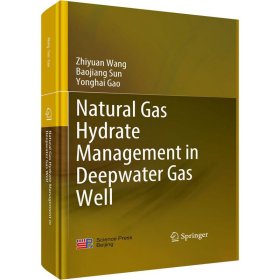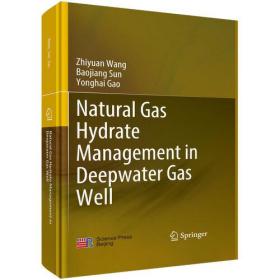
深水气井天然气水合物防治理论与技术
全新正版 现货速发
¥ 215.6 6.8折 ¥ 318 全新
库存5件
作者王志远,孙宝江,高永海 编
出版社科学出版社
ISBN9787030644190
出版时间2020-07
装帧精装
开本其他
定价318元
货号1202094338
上书时间2024-12-11
- 在售商品 暂无
- 平均发货时间 9小时
- 好评率 暂无
- 最新上架
商品详情
- 品相描述:全新
- 商品描述
-
目录
1 Overview on Hydrate Risks in Deepwater Oil and Gas Development 1
1.1 Engineering Background of Hydrate Risks 1
1.2 Hydrate Risks During Deepwater Drilling and Well Control 2
1.3 Hydrate Risks During Deepwater Gas Well Test 4
1.4 Hydrate Risks During Deepwater Oil and Gas Production 4
1.5 Management Measures for Hydrate Risks 5
References 6
2 Formation and Decomposition of Natural Gas Hydrate 9
2.1 Structure and Formation of NGH 9
2.2 Formation of NGH 13
2.2.1 Hydrate Phase Equilibrium Condition 13
2.2.2 Hydrate Formation Dynamics 19
2.2.3 Hydrate Formation in Gas Phase with Free Water and Its Rate 23
2.2.4 Hydrate Formation in Gas Phase Without Free Water and Its Rate 27
2.3 Decomposition of NGH 35
2.3.1 Hydrate Decomposition Above Freezing Point 36
2.3.2 Hydrate Decomposition Below Freezing Point 38
2.4 Formation and Decomposition of Hydrate Converted from Moving Bubbles 40
2.4.1 Mass Transfer Model of Moving Bubbles 40
2.4.2 Interphase Mass Transfer Rate 45
2.4.3 Formation and Decomposition of Hydrate Converted from Moving Bubbles 46
References 47
3 Prediction for NGH Formation Area in Deepwater Gas Well 51
3.1 Coupling Between Hydrate Behavior and Multi-phase Flow Characteristics 51
3.2 Prediction on Well/Pipeline Temperature and Pressure Fields in Annular-Mist Flow 53
3.2.1 Multiphase Flow Model 53
3.2.2 Model Solution 60
3.2.3 Model Validation 61
3.3 Prediction on Well/Pipeline Temperature and Pressure Field in Water-Saturated Gas Systems 65
3.3.1 Temperature Field Model 65
3.3.2 Pressure Field Model 67
3.4 Influencing Factors of NGH Phase Equilibrium in Well/Pipeline 67
3.4.1 Natural Gas Components 68
3.4.2 Natural Gas Density 68
3.4.3 Thermodynamic Inhibitor 69
3.4.4 Sand Content 70
3.5 Prediction and Influence Factors of Hydrate Formation Area in Deepwater Gas Well 73
3.5.1 Prediction Methods of Hydrate Formation Area Under Different Working Conditions 73
3.5.2 Influencing Factors of Hydrate Formation Area During Drilling 74
3.5.3 Influencing Factors of Hydrate Formation Area During Well Control 76
3.5.4 Influencing Factors of Hydrate Formation Area During Well Test 78
References 82
4 Influence of Hydrate Phase Transition on Multiphase Flow in Deepwater Gas Well 85
4.1 Influence of Hydrate Phase Transition on the Rheology of Drilling Fluid 85
4.1.1 Experimental Device 86
4.1.2 Drilling Fluid Rheology Model Considering Hydrate Formation 87
4.1.3 Hydrate Formation Integration Constant of CHF 90
4.2 Influence of Hydrate Phase Transition on Multiphase Flow During Deepwater Drilling 96
4.2.1 Well Annulus Multiphase Flow Model During Deepwater Drilling 96
4.2.2 Influence of Hydrate Phase Transition on Bubble Migration 101
4.2.3 Influence of Hydrate Phase Transition on Well Multiphase Flow Without Inhibitors 103
4.2.4 Influence of Hydrate Phase Transition on Well Multiphase Flow with Inhibitors 107
References 108
5 Mechanism and Prediction for Hydrate Deposition and Blockage in Deepwater Gas Well 111
5.1 Hydrate Particles Interactions 111
5.1.1 Interaction Force Between Hydrate Particles 114
5.1.2 Interaction Force of Hydrate Particle-Droplet-Hydrate Particle 118
5.1.3 Interaction Force of Hydrate Particle-Droplet-Hydrate Particle Considering Liquid Bridge Solidification 125
5.2 Hydrate Deposition and Blockage Model in Gas-Liquid-Solid Three-Phase Flow 130
5.2.1 Initial Deposition Model of Hydrate Particle in Gas Core 131
5.2.2 Influence of Liquid Film Atomization on Hydrate Particles Deposition 132
5.2.3 Effective Deposition Coefficient of Hydrate Particle in Gas Core 133
5.2.4 Hydrate Layer Growth and Hydrate Blockage 135
5.2.5 Model Solution and Validation 136
5.3 Hydrate Deposition and Blockage Model in Gas-Solid Two-Phase Flow 143
5.3.1 Theory on Radial Migration of Solid Particles in Gas-Solid Two-Phase Flow 144
5.3.2 Wells and Friedlander Model 144
5.3.3 Hydrate Particles Deposition in Gas-Solid Two-Phase Flow 147
5.3.4 Model Solution and Validation 149
5.4 Hydrate Deposition and Blockage Model in Water-Saturated Gas Single-Phase Flow 152
5.4.1 Hydrate Deposition and Blockage Model 153
5.4.2 Model Solution and Validation 154
5.5 Prediction for Hydrate Blockage During Deepwater Gas Well Control 156
5.5.1 Basic Parameters in Case 156
5.5.2 Prediction for Hydrate Formation Area 158
5.5.3 Laws of Hydrate Deposition and Blockage 158
5.5.4 Influence of Hydrate Deposition on Wellhead Back Pressure 166
5.6 Prediction for Hydrate Blockage During Deepwater Gas Well Test 167
5.6.1 Hydrate Blockage Free Window (HBFW) 167
5.6.2 Model Solution Steps 168
5.6.3 Quantitative Prediction for Hydrate Blockage 169
5.6.4 Case Analysis for Predicting the Hydrate Blockage 171
References 177
6 Technologies for Hydrate Management in Deepwater Gas Well 181
……
内容摘要
本书包括六章内容,可分为三个部分。第一部分(第二章)从海洋油气导管的功能入手,按照油气导管所处作业环境,将其分为水上井口和水下井口两类,分别重点介绍这两大类井口的探井和开发井油气导管主要组成及其结构特点,并给出国际典型的浅水和深水井口装置结构。第二部分(第三、四、五章)主要以海洋油气导管安装为目标,分别论述了海洋油气井安装油气导管的三种主流方法(分别是:钻入法、锤入法和喷射法)的施工工艺和装备,同时重点介绍了三种海洋油气导管安装方法的关键设计技术。在第一和第二部分基础上,第三部分结合地质、海洋环境和施工作业因素,重点分析了三种施工工艺的差异性和彼此的适用性,可为海洋油气导管安装方法选择提供科学依据。
相关推荐
-

深水气井天然气水合物防治理论与技术
全新北京
¥ 225.53
-

深水气井天然气水合物防治理论与技术
全新广州
¥ 214.61
-

深水气井天然气水合物防治理论与技术
全新南京
¥ 228.96
-

深水气井天然气水合物防治理论与技术
全新广州
¥ 252.55
-

深水气井天然气水合物防治理论与技术
全新保定
¥ 245.99
-

深水气井天然气水合物防治理论与技术
全新南京
¥ 228.96
-

深水气井天然气水合物防治理论与技术
全新南京
¥ 228.96
-

深水气井天然气水合物防治理论与技术
全新武汉
¥ 228.96
-

深水气井天然气水合物防治理论与技术
全新北京
¥ 242.35
-

深水气井天然气水合物防治理论与技术
全新泰州
¥ 232.14
— 没有更多了 —












以下为对购买帮助不大的评价